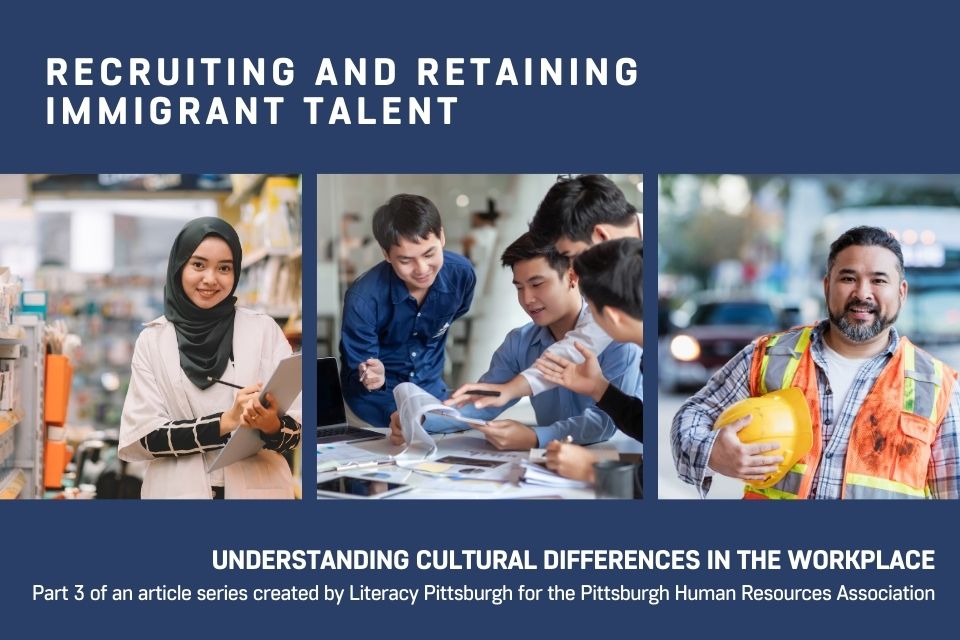
By Nicole Mannino Johnson, Special Projects Manager, Literacy Pittsburgh, njohnson@literacypittsburgh.org
Interpreting behavior can be tricky. Sometimes, what Americans perceive as unprofessional or rude could be a sign of a cultural difference. We will explore a few types of cultural differences that may be encountered in the workplace. Developing cultural competence improves professional communication and relationships.
What is cultural competence? While there are many definitions, for the purposes of this article, we will use the following: Function effectively as an individual and an organization within the context of the cultural beliefs, behaviors, and needs presented by employees, consumers, and the community. Culture encompasses beliefs, attitudes, traditions, language, values, and communication. In this article, we will focus on national cultural differences with an emphasis on immigrant groups residing in the United States.
Eye Contact and Body Language
At a team huddle, a supervisor is frustrated that some team members are disrespectful. They have their arms crossed and are looking down. This particular group of team members is from a non-western culture. In their culture, direct eye contact with a superior is disrespectful and rude, and crossing arms is a sign of listening. The supervisor shows unconscious bias when viewing the employees' body language and lack of eye contact as rude.
Eye contact preferences vary by culture and are deeply ingrained and not taught explicitly, making it difficult to interpret and difficult to change. In addition to being a cultural difference, eye contact can vary with neurodiverse populations. There's a common misunderstanding that a lack of eye contact indicates a lack of empathy or connection. Training supervisors and staff on body language and eye contact can benefit all.
Time and Punctuality
The concept of time varies across cultures. In Erin Meyer's Culture Map,1 she describes a continuum between linear time and flexible time. Edward T. Hall described views of time as monochronic or polychronic.2 The United States is linear or monochronic in its' views of time. US culture values punctuality and prefers to manage time very tightly. Polychronic or flexible time-oriented cultures value social interaction and encounters above tightly adhering to schedules. If they are in a meeting or encounter that is taking longer than expected, they will prefer to finish the meeting and arrive late to the next appointment. You can imagine how irritation and misunderstanding may arise when individuals with opposite time orientations interact. Each may interpret the other's behavior as rude. Understanding your own time orientation and your organization's preferences is important, as is understanding that someone may be coming from a different viewpoint. P-time people may prefer group work, while M-time people may prefer solo work. Allowing flexibility in working arrangements when possible can help to bridge the divide and improve relationships.
Personal Time Off
Many immigrants observe traditions or celebrate holidays not traditionally observed in American culture. Human Resources departments should become familiar with their employees' major holidays and celebrations, consider offering flexible scheduling, and be prepared for time-off requests. Some religious observances may prohibit work. Companies may wish to offer culturally sensitive greetings or holiday wishes during major holidays celebrated by their employees to both show respect to those employees and to educate other staff about their colleague's traditions. Some holidays and traditions to consider are:
- Spring Festival/Lunar New Year
In China, this is a 40-day period of celebration with a 7-day state holiday. The dates vary and depend on the lunar calendar. The first week is when the most significant events occur. Celebrated worldwide, it usually prompts the planet's largest annual migration of people.3 - Ramadan: Holy Month
This year, Ramadan began on March 10, 2024. The beginning day changes annually because it is set using the Islamic calendar, which follows the lunar cycle. The crescent moon sighting ultimately determines the day. Ramadan is the ninth month of the Islamic, or Hijri, calendar. Ramadan ends with Eid al-Fitr, also known as the Festival of Sweets or Festival of Breaking the Fast. It marks the end of the monthlong dawn-to-sunset fasting during Ramadan. Eid al-Fitr celebrations vary, but often include spending time with family and friends, gift-giving, charitable giving and festivals with food and activities.4 - Nowruz/Persian New Year
About 300 million people worldwide celebrate Nowruz, with traditions and rituals particularly strong in the Balkans, the Black Sea and Caspian Sea regions, the Caucasus, Central and South Asia, and the Middle East. Celebrated on the Spring Equinox, Nowruz events may include folk dance performances, special concerts, and tree planting ceremonies.5 - Funeral Traditions
In some cultures, funeral traditions are closely tied to religion and prohibit working during the period of mourning. The period of mourning can vary depending on the closeness of the relationship to the deceased. Some Hindu beliefs require 13–16 days of isolation and fasting. In many cultures, family members, not professional undertakers, take care of all funeral rites. Be aware that not granting time off could violate workers' religious rights.6
Investing time in developing cultural competence is essential in today's workplace. It can improve understanding, boost employee morale, and make employees from different cultures feel more welcome.
When most people think about management, they think about things like productivity, efficiency, and goal-setting. And while those are all important aspects of effective management, a growing body of research suggests that cultural competency is just as critical.7
This article is part three of a series by Literacy Pittsburgh with tips on hiring and retaining immigrant talent.
References
1 https://erinmeyer.com/books/the-culture-map/
3 https://www.nationalgeographic.com/history/article/lunar-new-year
4 https://www.un.org/en/observances/international-nowruz-day
5 https://www.usatoday.com/story/news/2024/02/08/when-is-ramadan-2024/72189474007/
7 https://www.hofstede-insights.com/intercultural-management
Literacy Pittsburgh (formerly Greater Pittsburgh Literacy Council) helps create better lives through learning. Recognized as a national leader in adult and family literacy, Literacy Pittsburgh is the largest provider of adult basic education in Allegheny and Beaver Counties. Last year, Literacy Pittsburgh helped more than 4,000 individuals acquire the skills needed to reach their fullest potential in life and participate productively in their communities. Literacy Pittsburgh provides free, personalized instruction in workforce readiness, high school diploma test preparation, digital literacy, English language learning, math, reading, and family literacy through one-to-one and small class instruction. Founded in 1982, it serves local adults through numerous neighborhood locations and its Downtown Pittsburgh Learning Center.


